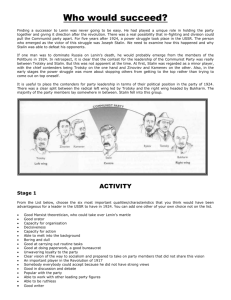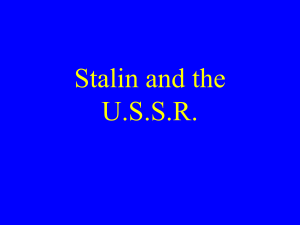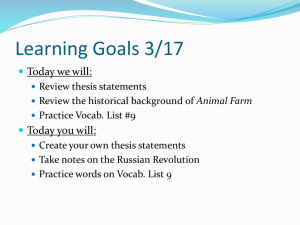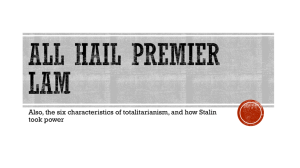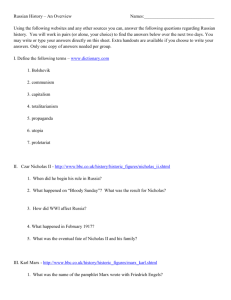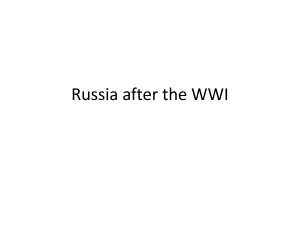Stalin and the USSR
advertisement
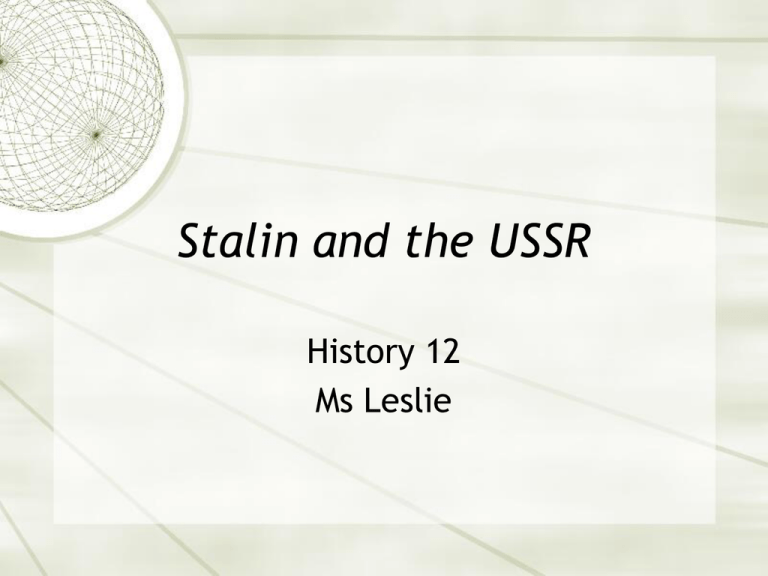
Stalin and the USSR History 12 Ms Leslie Who to Lead the USSR? 1. Moderates - wanted to continue NEP and slowly build up the communist state - Stalin pretended to be on their team to gain support 2. The Left opposition - impatient; wanted communism now. Led by Trotsky and Zinoviev and Kamenev The contenders Trotsky His high opinion of himself annoyed many but was valid. Many distrusted him due to his late conversion to Bolshevism. Was President of Worker’s and Soldier’s soviet, Minister of War and Minister of Foreign Affairs Was Jewish and From a well off family - facts that Stalin will use against him Kamenev and Zinoviev. They were influential in the party. Viewed Trotsky as their rival, not Stalin. Moderates Always a duo - like Clinton and Gore Stalin. Was a Georgian who had turned to Marxism after aiming for a career in the Georgian Orthodox Church He was tough. He was an organizer. He inserted his supporters in key positions of the party while General Secretary of the Central Committee. Weaseling his way to the top Stalin knows he needs to get rid of Trotsky so he points out that: Trotsky is Jewish, Rich and a late converter to communism. (Trotsky had only been a party member since 1917) Stalin got Zinoviev and Kamenev on his side and the three of them persuaded the Central Committee to ignore Lenin’s last will and testament which recommended Stalin’s removal for office. Stalin starts promoting ‘Socialism in One Country’ This means ignoring Lenin and Trotsky’s dreams of helping revolutions start in other countries It appealed to people’s patriotism while Trotsky’s vision was one of more struggle and hardship. Had to rebuild Russia - no money to spare spreading Communism globally Stalin removed Trotsky from his post in 1925. By 1926 Stalin had enough supporters in the Central Committee that he no longer needed Zinoviev and Kamenev, they were dismissed in 1927. What Happened to Trotsky? Trotsky fled in exile and traveled to many places until settling in Mexico. There he wrote many Socialists texts and reviews of the Russian Revolution and even had an affair with the famous Mexican Painter Frida 1930 Trotsky is put on trial in abstention and sentenced to death In 1940 Stalin felt threatened by Trotsky’s voice of dissent and sent a Secret police assassin to Mexico The assassin stabbed Trotsky in the head with an ice pick the blow did not kill Trotsky at first and Trotsky wrestled his assassin to the ground When his guards burst in to the room to kill the assassin Trotsky told them not to as the man ‘had a story to tell’ Trotsky was rushed to the hospital where he under went surgery but succumbed to his injuries the next day. Stalin, Industrialization and Collectivization Despite NEP keeping peasants happy, Stalin turns things down another path Need to increase production to go from socialism to communism 1928 - a big year for change Collectivization of agriculture. Stalin wanted to get rid of all private farms and impose an industrial model on the country side. Massive Industrialization. Industry was to be speeded up enormously. In doing so he would destroy the power of the Nepmen and their supporters in the party. 1928- The First 5 Year Plan 1. Command Economy Economics would be driven by state planning and not the free market. The government sets production levels, distribution and consumption What to make, where to sell it who can buy it. 2. Collectivization Stalin reversed Lenin’s NEP policy of giving the land to the peasants by forcing them to become workers on collective farms Collective farms were called Kolkhoz and would be run by a Collective Farm Committee which would be under control of party officials By January, 1930 there were 4 million peasants on collective farms. March, 1930 there were 14 million (55% of all farmers). The result was a disaster, not the predicted improvement. By 1931 it was only 53% due to the chaos and harsh process. By July, 1932 62% of peasant families were on collective farms. Some farmers would resist, which meant starvation as their grain would be seized to feed the cities or sell to foreign markets to pay for heavy industry. Stalin focused on the wealthier farmers, called Kulaks. Kulaks had machinery, employees and surplus to sell. In reality, there were only a few Kulaks But Stalin decided to eliminate this whole class as they represented free enterprise Any farmer could be labeled a Kulak, Entire villages even! Once they had this label they were considered class enemies and could be killed or sent to the gulag. In 1937 agricultural production was below to 1928 level. In 1933 there were less then half as many horses then the 1928 figure. The number of cattle fell by 1/3 and the number of sheep by 1/2 Horses were supposed to be replaced by tractors, but not enough were produced. About 5 million peasants died in the collectivization process and the famine the followed in 1932. Stalin would not admit the famine existed and would not allowed a famine relief program It was the farmers who paid for the industrialization of the USSR. It was pried out of their cold dead hands. 3. Industrialization The First Five Year Plan came into effect in April 1929. Production was to focus on industrial goods, not consumer goods. The goals were sky high: Total output to increase by 250% Heavy industry to grow 330% Pig Iron output by 300% Coal production to double Electrical out put to quadruple When party members challenged these figures Stalin raised them and changed the deadline to 4 years instead of 5. Would often say that the USSR had to do in 15 years what the West did in 150. Problems with industrialization Supplies and distribution means not there Factories did not have the right equipment, or equipment did not have factories to house them Products were made that did not work just to fill quotas Once product was made, there was no transportation to get the goods to markets Stalin would not let up on the targets Stalin and Unions The NEP had encouraged the growth and independence of unions. Stalin crushed them. In 1932 workers guilty of one day’s voluntary absence from work would cost them their job and housing. In 1931 and 32 legislation was passed to force workers to go where ever the authorities told them Papers please In 1932 the old Czarist system on internal passports was revived. Now people could only move with police consent. Wages Piece rate wages were introduced to replace fixed salaries. Meaning people were paid for each item produced not an hourly rate Skilled workers were paid more. There was also ‘material incentives’ to increase production such as better housing, holidays and consumer goods. To fail at achieving one’s production quota was to fail the party as well. The government used propaganda to create industrial heroes and provide a model for the New Soviet Man. The media was full of Shock Workers and Stakhanovites. Stakhanov was a coal worker; he and his crew were given an easy coal seam and the best equipment to break up 102 tons of coal in 1 shift. Over filling their quote by 1400%. The media spread this story all over an expectations for normal workers was heightened. Results of 1st-5yp Ended 1932, was a failure Successful in making a new society Production of Oil, Peat, sugar, coal, electrical fixtures, automobiles, tractors all reached their goals. But reliable figures stopped in 1931. Gulag system grew (3 million zuks) and now a permanent fixture in Russia society. Second 5 year Plan The Second 5 year plan was announced in 1933, to be completed in 1937. Deemed to severe and was modified in 1934 Its aim was to eliminated all capitalist elements in the USSR. Private business and trade had already been eliminated, except for Farmer’s markets and the black market. focused on improving the quality of goods. Wage differences increased. Collectivization continued to have problems. Overshadowing the Second Five year Plan which makes its achievements not too important was the Great Purge. Why did the the Purges happen? Paranoia due to Syphilis? Deep inferiority complex? German Gestapo creating havoc? 5 year plans creating too much dissent? Afraid of loosing power? When did he make the decision? Suicide of his 2nd wife in 1932 effecting him deeply She had criticized his terror and he yelled at her a stream of vulgar abuse and she shot herself He was visibly shaken, tried the resign from the party but they wouldn’t let him No longer trusts people close to him By 1934 Stalin announced there is no one left to fight as all the peasants and workers had been beaten into submission. Now going to focus on cleaning up the party It Begins Party officials began to think Stalin not a good person to lead USSR and promoted Kirov (2nd in command) as a replacement Stalin sends Kirov to Leningrad to clean up the rest of Zinoviev supporters there. On Dec 1st he is assassinated by one of Z’s supporters (under Stalin’s command) Stalin uses this as an excuse to hunt opposision - Within months hundreds of ‘Kirov’s murderers’ are sent to Siberia Z and K are given prison sentences for Kamenev and Zinoviev were put on ‘show trial’. These were public trials were the accused were forced into confession with various tactics. K and Z were forced to confess to plotting against Stalin with Trotsky to take over the USSR. People would confess after torture or threats to the safety of their family. K and Z were shot in 1936. It was later revealed in 1956 by Khruschev that Stalin had ordered Kirov’s murder Show trials dramatic and bizarre Has high-ranking communists All on Lenin’s original Politburo except Stalin Rykov- an ex premier Ztukhachevsky - chief of staff Tomsky - ex-chief of trade unions Trotsky (who is in Mexico) The world was astounded to how everyone would confess to the most wildest accusations There was little truth to the claims EG meetings in hotels that no longer exists or non existing flights landing in airports No one was safe from the Purge. The Army, air force and navy all had casualties in the top ranks. 1/5 of the officer corps was lost. Stalin even shot the leader of the NKVD to prove that no one was safe. Nikolai Yezhov, an NKVD leader photographed alongside Stalin in at least one photograph, was shot in 1940 and subsequently edited out of the photograph. Who carried out the purges? Stalin had created his own secret police. The NKVD (People's Commissariat for Internal Affairs) was the public and secret police organization of the Soviet Union that directly executed the rule of terror, including political repression, during the Stalinist era. Who’s the NKVD? The NKVD contained the regular, public police force of Soviet Russia and the USSR (including traffic police, firefighting, border guards and archives) but is better known for the activities of the Gulag and eventually becoming the Committee for State Security (KGB). But what did they do? conducted mass extrajudicial executions, ran the Gulag system of forced labor, suppressed underground resistance, conducted mass deportations of nationalities and "Kulaks" to unpopulated regions of the country, guarded state borders, conducted espionage and political assassinations abroad, was responsible for influencing foreign governments, and enforced Stalinist policy within Communist movements in other countries Millions of ordinary citizens also accused Orders sent out to the NKVD to arrest a certain percentage of the population As many as 8 million were arrested Why Confess? Confessions made through torture - physical and mental. Thought confessing would bring a lighter sentence Save their families End the torture Final service to the party - be the last to die for the party to stop the bloodshed And if you didn’t confess? Secret trials… or just simply an execution with out trial Fate of all military leaders Was there any truth to the confessions? Not really What did the Great Purge Accomplish? Stalin is unchallenged totalitarian master A whole lot of slave labour How did Stalin get away with it? Cult of Personality. A cult of personality arises when a country's leader uses mass media to create a heroic public image, often through unquestioning flattery and praise. strong and vivid personality Knew how to charm people Name linked with Lenin May 5, 1920, Lenin gave a speech to a crowd of Soviet troops in Sverdlov Square, Moscow. In the foreground was Leon Trotsky and Lev Kamenev. The photo was later altered and both were removed by censors. Stalin knew how popular Lenin was and saw to it that history was rewritten in such a way as to make his own relations with Lenin seem much more friendly than they had been in fact. The rewriting was so thorough that perhaps Stalin himself believed his own version in the end.
